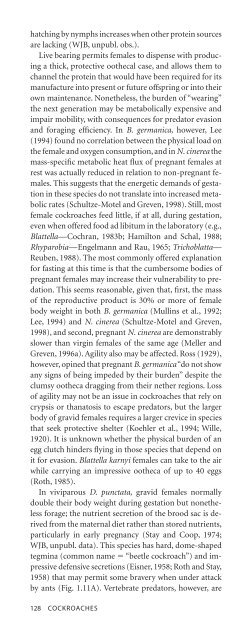Cockroache; Ecology, behavior & history - W.J. Bell
Cockroache; Ecology, behavior & history - W.J. Bell
Cockroache; Ecology, behavior & history - W.J. Bell
Create successful ePaper yourself
Turn your PDF publications into a flip-book with our unique Google optimized e-Paper software.
hatching by nymphs increases when other protein sources<br />
are lacking (WJB, unpubl. obs.).<br />
Live bearing permits females to dispense with producing<br />
a thick, protective oothecal case, and allows them to<br />
channel the protein that would have been required for its<br />
manufacture into present or future offspring or into their<br />
own maintenance. Nonetheless, the burden of “wearing”<br />
the next generation may be metabolically expensive and<br />
impair mobility, with consequences for predator evasion<br />
and foraging efficiency. In B. germanica, however, Lee<br />
(1994) found no correlation between the physical load on<br />
the female and oxygen consumption, and in N. cinerea the<br />
mass-specific metabolic heat flux of pregnant females at<br />
rest was actually reduced in relation to non-pregnant females.<br />
This suggests that the energetic demands of gestation<br />
in these species do not translate into increased metabolic<br />
rates (Schultze-Motel and Greven, 1998). Still, most<br />
female cockroaches feed little, if at all, during gestation,<br />
even when offered food ad libitum in the laboratory (e.g.,<br />
Blattella—Cochran, 1983b; Hamilton and Schal, 1988;<br />
Rhyparobia—Engelmann and Rau, 1965; Trichoblatta—<br />
Reuben, 1988). The most commonly offered explanation<br />
for fasting at this time is that the cumbersome bodies of<br />
pregnant females may increase their vulnerability to predation.<br />
This seems reasonable, given that, first, the mass<br />
of the reproductive product is 30% or more of female<br />
body weight in both B. germanica (Mullins et al., 1992;<br />
Lee, 1994) and N. cinerea (Schultze-Motel and Greven,<br />
1998), and second, pregnant N. cinerea are demonstrably<br />
slower than virgin females of the same age (Meller and<br />
Greven, 1996a). Agility also may be affected. Ross (1929),<br />
however, opined that pregnant B. germanica“do not show<br />
any signs of being impeded by their burden” despite the<br />
clumsy ootheca dragging from their nether regions. Loss<br />
of agility may not be an issue in cockroaches that rely on<br />
crypsis or thanatosis to escape predators, but the larger<br />
body of gravid females requires a larger crevice in species<br />
that seek protective shelter (Koehler et al., 1994; Wille,<br />
1920). It is unknown whether the physical burden of an<br />
egg clutch hinders flying in those species that depend on<br />
it for evasion. Blattella karnyi females can take to the air<br />
while carrying an impressive ootheca of up to 40 eggs<br />
(Roth, 1985).<br />
In viviparous D. punctata, gravid females normally<br />
double their body weight during gestation but nonetheless<br />
forage; the nutrient secretion of the brood sac is derived<br />
from the maternal diet rather than stored nutrients,<br />
particularly in early pregnancy (Stay and Coop, 1974;<br />
WJB, unpubl. data). This species has hard, dome-shaped<br />
tegmina (common name “beetle cockroach”) and impressive<br />
defensive secretions (Eisner, 1958; Roth and Stay,<br />
1958) that may permit some bravery when under attack<br />
by ants (Fig. 1.11A). Vertebrate predators, however, are<br />
threats, and lizards, toads, and birds have been observed<br />
eating them in the field (Roth and Stay, 1958; WJB, pers.<br />
obs.). It is possible that D. punctata females rely on readily<br />
accessible, predictable sources of high-quality food for<br />
supporting the explosive growth of their embryos. Their<br />
diet, however, appears little different from that of many<br />
other cockroaches.<br />
Reduced Fecundity<br />
One of the most significant costs exacted by carrying egg<br />
cases lies in terms of fecundity. Oviparous type A cockroaches<br />
have relatively high reproductive rates because<br />
the interval between successive oothecae is short, usually<br />
much shorter than the period of incubation. Females typically<br />
produce a second egg case long before the first laid<br />
hatches. Oviparous species with external egg retention as<br />
well as ovoviviparous females produce relatively few<br />
oothecae because oocytes do not mature in the ovaries<br />
while an ootheca is being carried. Viviparity is particularly<br />
expensive, in that female D. punctata have fewer eggs<br />
per oothecae, produce fewer oothecae per lifetime, and<br />
have a longer period of gestation than any other blaberid<br />
(Roth and Stay, 1961; Roth, 1967d). Consequently, the<br />
number of egg cases per lifetime decreases and the oviposition<br />
interval increases in the order oviparous, ovoviviparous,<br />
viviparous (Fig. 7.9) (Willis et al., 1958; Roth and<br />
Stay, 1959, 1962a; Breed, 1983).<br />
Fecundity also appears reduced in cockroach species<br />
that exhibit parental care, particularly if the care involves<br />
feeding young dependents on bodily fluids. Such pabulum<br />
may be demanding in terms of the structures involved<br />
in its manufacture, the nutrients incorporated into<br />
the secretions, and the energy required to produce them.<br />
Fig. 7.9 Frequency of oviposition by individuals of different<br />
species of cockroach. Each dot represents the formation of an<br />
ootheca; the length of the line is the adult lifespan of the female.<br />
Symploce pallens ( hospes) and Supella longipalpa (Blattellidae)<br />
are oviparous and drop the ootheca shortly after it is<br />
formed. Blattella germanica and B. vaga (Blattellidae) carry<br />
their ootheca externally until the eggs hatch. The blaberids<br />
Pycnoscelus surinamensis (parthenogenetic) and Nauphoeta<br />
cinerea are ovoviviparous, and Diploptera punctata is viviparous.<br />
After Roth (1970a).<br />
128 COCKROACHES


